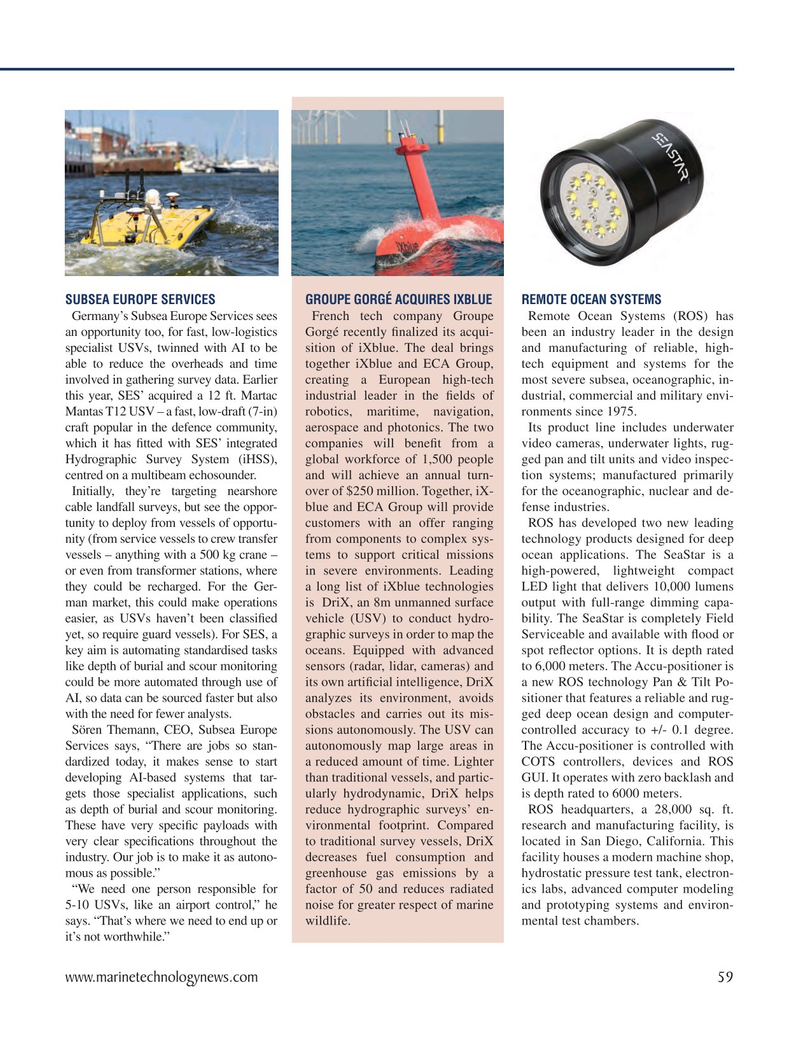
Page 59: of Marine Technology Magazine (September 2022)
Read this page in Pdf, Flash or Html5 edition of September 2022 Marine Technology Magazine
SUBSEA EUROPE SERVICES GROUPE GORGÉ ACQUIRES IXBLUE REMOTE OCEAN SYSTEMS
Germany’s Subsea Europe Services sees French tech company Groupe Remote Ocean Systems (ROS) has an opportunity too, for fast, low-logistics Gorgé recently ? nalized its acqui- been an industry leader in the design specialist USVs, twinned with AI to be sition of iXblue. The deal brings and manufacturing of reliable, high- able to reduce the overheads and time together iXblue and ECA Group, tech equipment and systems for the involved in gathering survey data. Earlier creating a European high-tech most severe subsea, oceanographic, in- this year, SES’ acquired a 12 ft. Martac industrial leader in the ? elds of dustrial, commercial and military envi-
Mantas T12 USV – a fast, low-draft (7-in) robotics, maritime, navigation, ronments since 1975.
craft popular in the defence community, aerospace and photonics. The two Its product line includes underwater which it has ? tted with SES’ integrated companies will bene? t from a video cameras, underwater lights, rug-
Hydrographic Survey System (iHSS), global workforce of 1,500 people ged pan and tilt units and video inspec- centred on a multibeam echosounder. and will achieve an annual turn- tion systems; manufactured primarily
Initially, they’re targeting nearshore over of $250 million. Together, iX- for the oceanographic, nuclear and de- cable landfall surveys, but see the oppor- blue and ECA Group will provide fense industries.
tunity to deploy from vessels of opportu- customers with an offer ranging ROS has developed two new leading nity (from service vessels to crew transfer from components to complex sys- technology products designed for deep vessels – anything with a 500 kg crane – tems to support critical missions ocean applications. The SeaStar is a or even from transformer stations, where in severe environments. Leading high-powered, lightweight compact they could be recharged. For the Ger- a long list of iXblue technologies LED light that delivers 10,000 lumens man market, this could make operations is DriX, an 8m unmanned surface output with full-range dimming capa- easier, as USVs haven’t been classi? ed vehicle (USV) to conduct hydro- bility. The SeaStar is completely Field yet, so require guard vessels). For SES, a graphic surveys in order to map the Serviceable and available with ? ood or key aim is automating standardised tasks oceans. Equipped with advanced spot re? ector options. It is depth rated like depth of burial and scour monitoring sensors (radar, lidar, cameras) and to 6,000 meters. The Accu-positioner is could be more automated through use of its own arti? cial intelligence, DriX a new ROS technology Pan & Tilt Po-
AI, so data can be sourced faster but also analyzes its environment, avoids sitioner that features a reliable and rug- with the need for fewer analysts. obstacles and carries out its mis- ged deep ocean design and computer-
Sören Themann, CEO, Subsea Europe sions autonomously. The USV can controlled accuracy to +/- 0.1 degree.
Services says, “There are jobs so stan- autonomously map large areas in The Accu-positioner is controlled with dardized today, it makes sense to start a reduced amount of time. Lighter COTS controllers, devices and ROS developing AI-based systems that tar- than traditional vessels, and partic- GUI. It operates with zero backlash and gets those specialist applications, such ularly hydrodynamic, DriX helps is depth rated to 6000 meters.
as depth of burial and scour monitoring. reduce hydrographic surveys’ en- ROS headquarters, a 28,000 sq. ft.
These have very speci? c payloads with vironmental footprint. Compared research and manufacturing facility, is very clear speci? cations throughout the to traditional survey vessels, DriX located in San Diego, California. This industry. Our job is to make it as autono- decreases fuel consumption and facility houses a modern machine shop, mous as possible.” greenhouse gas emissions by a hydrostatic pressure test tank, electron- “We need one person responsible for factor of 50 and reduces radiated ics labs, advanced computer modeling 5-10 USVs, like an airport control,” he noise for greater respect of marine and prototyping systems and environ- says. “That’s where we need to end up or wildlife. mental test chambers. it’s not worthwhile.” www.marinetechnologynews.com 59
MTR #7 (50-65).indd 59 10/3/2022 12:10:15 PM

 58
58

 60
60
